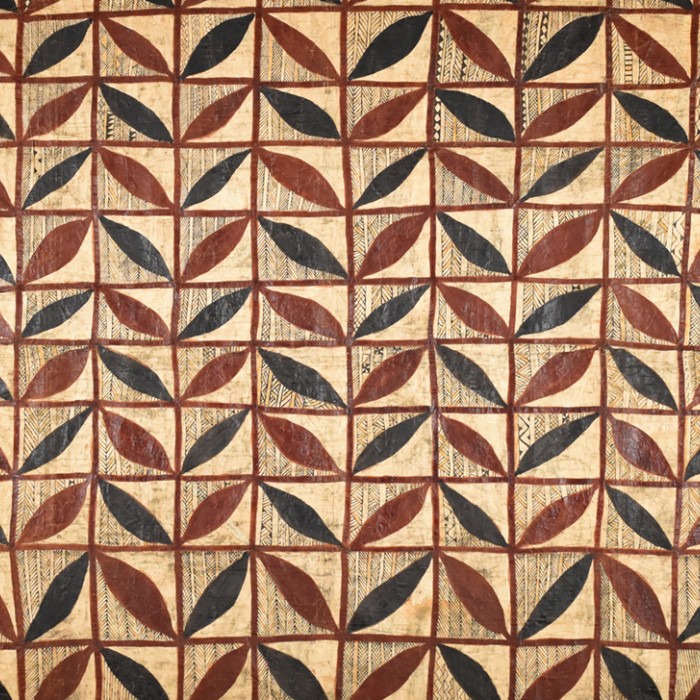
What Are Tapa and Woven Mats?

Faitau itulau ile gagana Samoa
There are so many ways to become involved in the history of the art and science of tapa and fine mats. It is my hope that young Pacific people are inspired and engaged by the legacies of their ancestors to find ways to craft connections to their own stories, ways of being, and visions of our world.
–Kirisitina Sailiata (Samoan)
What began as a National Endowment for the Humanities grant to conserve and share the tapa and woven mats at NHMLAC has blossomed into a collaboration with multiple Pacific Island communities in Southern California. We are grateful for the help of the many community advisors who worked on this exhibition. We are in process of establishing an advisory council to partner with us as we work toward our goals of introducing this collection of tapa and finely woven mats to a larger audience and creating a useful resource for anyone with a connection to these stunning examples of Pacific Island cultural heritage.
Interested in finding out more or joining the community? Leave us your information. We welcome comments and feedback on our collection or this website, as well as any stories or information you may like to share about tapa and woven mats.
The origins of this project are in NHMLAC's collection of over 450 tapa and woven mats, some of which are over 150 years old. In 2020, we received a grant to go through the collection item by item, documenting via high-resolution photography and noting and treating any conservation issues. We also received funds to create an online exhibition and share the collection, which has never been shown in its entirety.
Because of the issues with holding, conserving, researching, displaying, and interpreting objects from only the museum point of view, or without input from the communities that the items originated from, we reached out to various advisors from different Pacific Islander organizations around Southern California. The project began with a blessing by Samoan, Marshallese, Hawaiian and Chamorro elders, as well as tribal elders from the local Tongva community on whose land the museum is located and who provided their blessing and permission.
It’s important for people to know that these are not gestural acts but a tradition of Indigenous communities sharing and extending respect, honor, spirit and aloha!
—Cindi Alvitre (Tongva)
This blessing was followed by conversations about how the exhibition could address the needs of their communities. The elders then recommended community members who first advised us on protocols concerning community outreach, particularly during the global pandemic. The community advisors who worked closely with us on exhibition development and content advised on the goals and structure of the website and the presentation of the cultural material. This collaborative process was integral to both situating the collection with Indigenous knowledge and presenting the material to the broader public with this knowledge.
Community members asked for transparency about the collectors and collection; for access to high-resolution images; the ability to contribute to research; and for educational curriculum based on exhibition content. Moreover, they asked for a place to showcase the diversity and importance of their various cultures (including but not limited to Samoan, Tongan, Fijian, and Hawaiian). This exhibition achieves some of these goals, and others are in process. There is much to be done, and we are grateful for the collaboration thus far.
The Natural History Museums of Los Angeles County wish to thank the following people for their support with this project:
The Natural History Museums of Los Angeles County wish to thank the following community members for their support with this project: Audrey Alo, Cindi Alvitre, Juliann Anesi, Katrina Talei Igglesden, Fran Lujan, Kirisitina Sailiata, Tavae Samuelu, Kelani Silk, Lolofi Soakai, Asena Taione-Filihia, and Craig Torres. The Fabric of Community has been made possible in part by a major grant from the National Endowment for the Humanities (NEH): Democracy demands wisdom. Any views, findings, conclusions, or recommendations expressed in this exhibition do not necessarily represent those of the NEH.